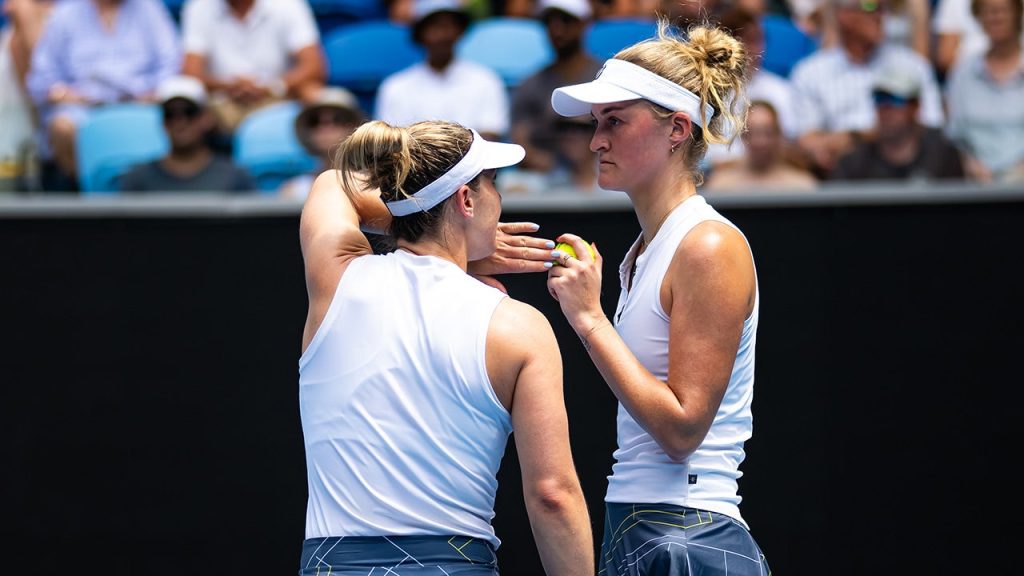Erin Routliffe, a professional tennis player representing New Zealand, found herself at the center of a viral moment during the Australian Open women’s doubles third-round match. Partnered with Canada’s Gabriela Dabrowski, Routliffe’s frustration boiled over regarding a contested serve by their opponent, Beatriz Haddad Maia of Brazil. The crux of the dispute arose during a crucial first-set tiebreak when Haddad Maia’s serve appeared to graze the net. The chair umpire, however, did not call a let, awarding the point to Haddad Maia and her partner, Laura Siegemund.
Routliffe’s immediate reaction captured the attention of spectators and social media alike. Incredulous at the lack of technological intervention for such a critical judgment, she exclaimed, “Oh my god, we have robots everywhere, but we don’t have one for the net? Oh my goodness.” Her outburst underscored a growing sentiment in professional tennis concerning the role of technology in officiating. While electronic line-calling systems are commonplace, the absence of a similar system for net cord judgments remains a point of contention. The incident highlighted the pressure-cooker environment of grand slam tournaments, where every point can drastically alter the course of a match, and the amplified emotional responses such situations can elicit.
Despite her vehement protest, the umpire’s call stood, leaving Routliffe momentarily flustered. However, the incident seemingly galvanized her and Dabrowski, as they quickly regrouped, winning the subsequent point and ultimately securing the match victory. This resilience demonstrated their ability to compartmentalize and refocus, a vital attribute in the high-stakes world of professional tennis. Their triumph propelled them to the semifinals, a testament to their ability to overcome adversity and channel their frustration into constructive performance.
The aftermath of the match saw Routliffe’s outburst gain traction on social media, sparking a broader discussion about the use of technology in tennis officiating. Acknowledging the intensity of her reaction, Routliffe later addressed the incident on X (formerly Twitter), admitting that her behavior might have been “dramatic” while maintaining her conviction about the need for net cord technology. Her self-aware commentary further fueled the online debate, with fans and analysts weighing in on the merits of her argument and the broader implications for the future of tennis officiating.
The incident involving Routliffe illuminated several key aspects of the modern tennis landscape. Firstly, it highlighted the increasing reliance on technology in officiating, with electronic line calls now widely accepted and contributing to the fairness and accuracy of the game. This reliance, however, also raises questions about the limitations of current technology and the potential for further advancements, particularly regarding net cord judgments. The debate extends beyond the immediate context of Routliffe’s match, raising fundamental questions about the balance between human judgment and technological intervention in sports.
Secondly, the incident showcased the immense pressure experienced by professional athletes at the highest level of competition. The emotional intensity of grand slam tournaments, coupled with the often-controversial nature of close calls, can create highly charged moments like the one witnessed in Routliffe’s match. While her outburst might have been viewed as excessive by some, it also offered a glimpse into the mental fortitude required to compete at the pinnacle of the sport. The ability to manage emotions and refocus after setbacks is crucial for success in professional tennis, and Routliffe’s and Dabrowski’s subsequent performance demonstrated their capacity to do just that. Finally, the incident sparked a wider conversation about the role of technology in shaping the future of tennis and sports in general. As technology continues to advance, the question of its appropriate implementation in sports officiating will likely remain a topic of ongoing debate. The incident involving Erin Routliffe served as a microcosm of this larger debate, highlighting both the potential benefits and the potential challenges of incorporating more technology into the game.

